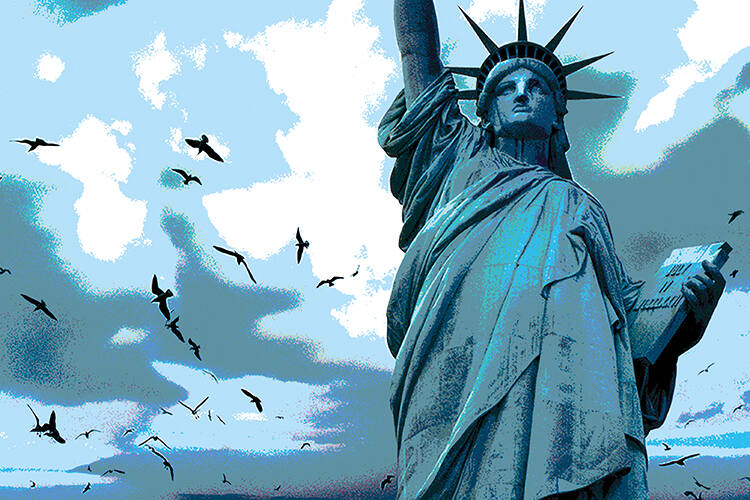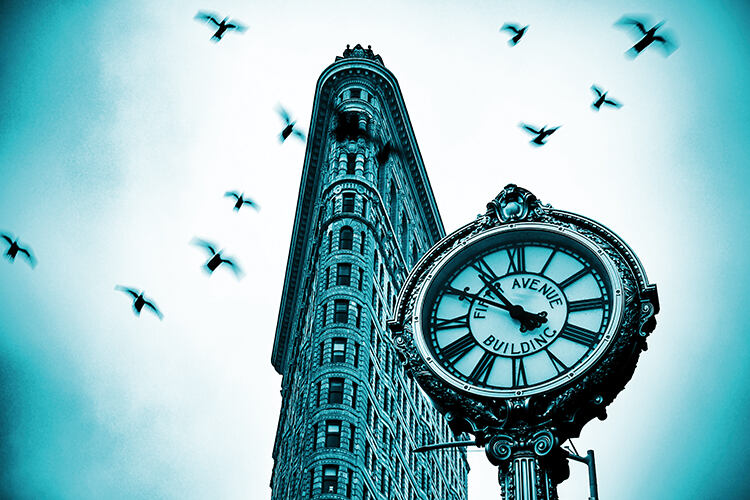
New York sits on one of the USA’s main bird migration routes. Each year, hundreds of thousands die after flying into brightly lit skyscrapers, but efforts are ongoing to get the lights switched off
By
Every year, millions of migrating birds cross the skies of New York City along one of the world’s busiest avian routes. Of these, up to 250,000 don’t make it. These unfortunates end up dead in the city’s streets, victims of collisions with brightly lit buildings.
‘Artificial light at night draws migratory birds into cities like moths to a flame,’ says Dustin Partridge, director of conservation and science at NYC Audubon. ‘Artificial light overrides migratory birds’ ability to navigate, causing them to collide directly with the light source or pulling them into the brightly lit parts of the city and exposing them to the daytime threat of collisions.’

Migratory birds need to rest and refuel in vegetation, something that’s limited in most of New York City. ‘When glass reflects vegetation or shows a clear flight path, birds perceive this as real,’ continues Partridge. ‘They then fly toward it, trying to enter the vegetation or fly through and instead end up colliding. The reflection of vegetation is why most collisions happen below 100 feet [30 metres] – approximately the height of the tree canopy. Birds cannot perceive architectural cues such as frames or mullions that allow people to know that glass is present.’
Flyways are historical flight paths used by large numbers of birds migrating between their breeding grounds and overwintering quarters. New York City lies on the Atlantic Flyway – the route that takes migratory birds from South America and the Caribbean up the Atlantic coast to Canada. More than 100 species have been identified as collision victims – typically songbirds such as sparrows and warblers; white-throated sparrows and the common yellowthroat are the most common collision victims.

About 80 per cent of North America’s migratory birds migrate at night. Night time usually brings calmer and cooler air, so birds expend less energy from flapping and less body fluid through evaporation. They’re also much less likely to bump into a predator after dark. But these are the hours during which artificial light, a relatively new addition to the night sky, contributes to the nearly one billion bird deaths by collision each year in North America.
This disturbing fact is driven home at the annual Tribute in Light ceremony to honour the victims of the Twin Towers terrorist attack of 2001. On the night of 11 September, the twin beams of eighty-eight, 7,000-watt xenon bulbs reach more than six kilometres into the sky, a sight that can be seen from a 95-kilometre radius around lower Manhattan. While a formidable ceremony, the event is also a powerful display of how disruptive artificial light is to migratory birds. There might be some 500 birds crossing that spot before the beams are lit; within minutes, their numbers can increase to about 15,000.
Legislators, wildlife-protection groups such as Audubon and concerned New Yorkers alike have been aware of this problem for decades. As far back as 1966, the management of the Empire State Building agreed to trial a two-month shutdown of floodlights that illuminate the iconic skyscraper’s top 30 floors. This was in response to complaints from scientists that on foggy, rainy or cloudy nights, floodlit buildings disrupted bird flight patterns. The tower’s lights are now switched off at 2am, marking a reversal of a near-century-old practice of leaving the building’s 6,514 window lights on, originally to give the impression of business as usual during the Depression.

Audubon has launched a campaign initiative, Project Safe Flight, designed to make the city more bird friendly and ensure a safer passage for migrating birds. ‘Our volunteers are out early each morning to search for dead or injured birds,’ says Partridge. ‘We discuss the problem with building owners and work with them to diminish their lighting at night or make their buildings bird safe using films that allow glass to be visible to birds. These efforts are effective but they are building by building, and in a city with nearly one million buildings, there will always be more to do.’
Audubon and other avian-support groups are hopeful that a bill put forward by New York City Council member Francisco P Moya will add vital political muscle to their cause. The proposal would make it mandatory for many privately owned commercial buildings to reduce their lighting at night. Legislation requiring city-owned or-occupied buildings to abide by lights out has been in place since 2021. What didn’t pass in that year was the private and commercial buildings requirement, which is what Moya has now introduced.
The bill under consideration by the city council in 2021 failed to make it to a vote after opposition from the Real Estate Board of New York. Commercial developers argued in their testimony that ‘realising the goals of this law would dramatically disrupt the operations of commercial buildings’. They voiced concern about staff time needed to implement the policy and the importance of security lighting. Nevertheless, in that year, the city council was able to pass two other laws that made it mandatory for lights to be dimmed in buildings owned and operated by the city. Regulating lighting in private buildings is seen as the crucial next step.

Moya says the implementation of this piece of legislation would encompass all of New York’s five boroughs. ‘The enforcement measures specifically target empty buildings that remain illuminated well after business hours and are classified as premises used to conduct business in the commercial space, industrial and office settings,’ he says. ‘These classifications were chosen because they are such broad building-code groups to allow this legislation to make a significant reduction to light pollution negatively impacting our city’s environment and endangering wildlife.’
Moya says his office has established a partnership with wildlife advocates, particularly NYC Audubon, along with scientists, who’ve played a crucial role in the development of this legislation. Audubon’s Dustin Partridge says he fully supports Moya’s initiative and believes that ‘it will have a profound effect in reducing bird impacts’.
The idea for this bill was triggered in early 2023 when Moya’s office was approached by advocates and ornithologists from Cornell University, who highlighted the serious nature of this problem. ‘I strongly believe in legislation that not only benefits our environment but our wildlife as well,’ says Moya. ‘This simple piece of legislation is based on us witnessing a huge number of bird deaths in New York City each year. Why walk past these dead birds on the sidewalk when we can do something as simple as switch off a light to prevent it? This legislation will also have a beneficial impact on our city’s carbon footprint.’
‘Councilman Moya’s legislation is so important because it will prevent collisions by targeting the root of the problem: artificial light at night,’ says Partridge. ‘The people of New York City are sick of seeing dead birds on the pavement every spring and fall morning. Lights out will help stop New York City from being a lethal barrier to birds during migration, bolstering bird populations across the Americas and making walking the streets a more pleasant experience for city residents in the morning.’




